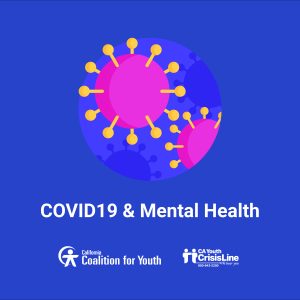
The following references a notice from the Departments of Health Care Services and Public Health and the Office of the Surgeon General.
With the rise in COVID-19 cases in California and across the United States, there is a growing concern over the epidemic’s immediate and long-term impacts on the mental health of our youth and families.
Social isolation, financial insecurity, and unemployment all drive increases in deaths from suicide, overdose, and illness, disproportionately impacting communities of color. Individuals who have a history of Adverse Childhood Experiences (ACEs) are particularly at risk. We all have the opportunity to screen, intervene and prevent these events from happening to our State’s youth.
As we move into our fifth month of COVID-19, where many of our youth are still sheltering at home with family or staying isolated, you have the opportunity to screen, intervene and prevent these events.
There is no way to know if someone is in trouble unless you ask. When you ask, there are tools and resources you can offer that can save a life.
The National Institute on Mental Health (NIMH) developed the Ask Suicide-screening Questions (ASQ), four questions in 20 seconds to identify people at risk of suicide. In a NIMH study, a “yes” response to one or more questions identified 97% of youth aged 10 to 21 at risk of suicide:
- In the past few weeks, have you wished you were dead?
- In the past few weeks, have you felt that you or your family would be better off if you were dead?
- In the pas week, have you been having thoughts about killing yourself?
- Have you ever tried to kill yourself?
What’s Next?
If an individual responds “yes” to one or more of the four Ask Suicide-Screening Questions, they are at “imminent risk” or “potential risk” of suicide.
To better understand risk-level, ask “are you having thoughts of killing yourself right now?” and if the individual says “yes,” then they are at imminent risk of suicide and need an urgent mental health evaluation to ensure immediate safety. If the individual answers “no,” then a potential risk is identified and they require a brief suicide safety assessment to determine next steps.
The Zero Suicide Model is an evidence-based practice outlining how to apply this model in a clinical setting. Practices include:
- Make a safety plan the youth can follow to take action if thoughts of suicide appear, including calling or texting help lines such as the California Youth Crisis Line (800-843-5200) or the National Suicide Prevention Lifeline (800-273-8255).
- Discuss restricting access to things they might use to hurt themselves – especially firearms.
- Create a follow-up monitoring plan to ensure the patient receives ongoing help and support.
Overdose and Suicide: An overdose or self-harm event in the emergency department indicates an extreme high risk. An opioid overdose indicated an 18-fold greater risk of suicide and over 100-fold greater risk of overdose in the next year, compared to the general population. A visit for suicidal ideation led to a 30-fold increase in the risk of suicide in the next year.
ACEs and Suicide: Individuals with four or more ACEs are 37.5 times as likely to attempt suicide, when compared to individuals with no ACEs. For more information on addressing ACEs in your clinical practices, visit www.ACEsAware.org.
Screening Individuals for risk of suicide saves lives! Health care professionals can help people get needed care and resources.
Other Tools and Resources
There are a number of amazing free resources and tools available via call or text. Youth and families in crisis can always call or text the California Youth Crisis Line at 800-843-5200 or chat with one of our volunteer counselors online at www.calyouth.org/chat. Another resource is the COVID-19 emotional support website which has resources for people at risk of suicide, there you can find suicide hotlines, crisis lines, peer support lines, and other resources for people experiencing stress from the emergency, including how to find substance use disorder treatment.
For our Youth Mental Health Service Providers and Counselors, Don’t Forget About Help for Yourself
Youth mental health service providers may be feeling stressed, anxious, overwhelmed or burned out by practicing on the front lines. Mental/Health workers are also at higher risk of suicide, and you are not alone. If you are a Mental/Health worker you can reach out for free counseling from volunteers at the COVID-19 counseling website. There is support for you. If you want to talk to someone, there are professionals ready to support you to keep supporting others.
Lastly, the Office of the California Surgeon General has a simple guide with things you can do everyday, at home, to help support your mental and physical health, utilizing six key strategies:
- Supportive Relationships,
- Exercise,
- Sleep,
- Nutrition,
- Mental Health Support, and
- Mindfulness
You can learn more in the California Surgeon General’s Playbook: Stress Relief during COVID-19. The guide is also available in Arabic, Chinese, Korean, Spanish, Tagalog, and Vietnamese.
click here to download and distribute our PDF version of this post.
________
References:
Suicide-Screening Questions: https://www.nimh.nih.gov/research/research-conducted-atnimh/asq-toolkit-materials/index.shtml
NIMH Study: https://pubmed.ncbi.nlm.nih.gov/23027429/
Zero Suicide Model: https://www.ncbi.nlm.nih.gov/pmc/articles/PMC5829088/
Major risk factors for completed suicide: https://www.hsph.harvard.edu/meansmatter/means-matter/risk/
Data on suicide risk after ED visit: https://jamanetwork.com/journals/jamanetworkopen/fullarticle/2757488
County behavioral health access line: https://www.dhcs.ca.gov/individuals/Pages/MHPContactList.aspx
COVID-19 emotional support website: https://covid19.ca.gov/resources-for-emotionalsupport-and-well-being/
COVID-19 counseling website: https://www.covid19counselingca.org/
Suicide Prevention Safety Plan Template: https://suicidepreventionlifeline.org/wpcontent/uploads/2016/08/Brown StanleySafetyPlanTemplate.pdf
Safety Planning Quick Guide for Clinicians https://www.sprc.org/resources-programs/safety-planning-guide-quick-guide-clinicians
California Surgeon General’s Playbook: Stress Relief During COVID-19 https://covid 19.ca.qov/imq/wp/california-surgeon-general stress-busting-playbook draftv2clean ada-04072020.pdf
Research on ACES: Hughes K, Bellis MA Hardcastle KA et al. The effect of multiple adverse childhood experiences on health: a systematic review and meta-analysis. Lancet Public Health 2017: 2: e356-66
